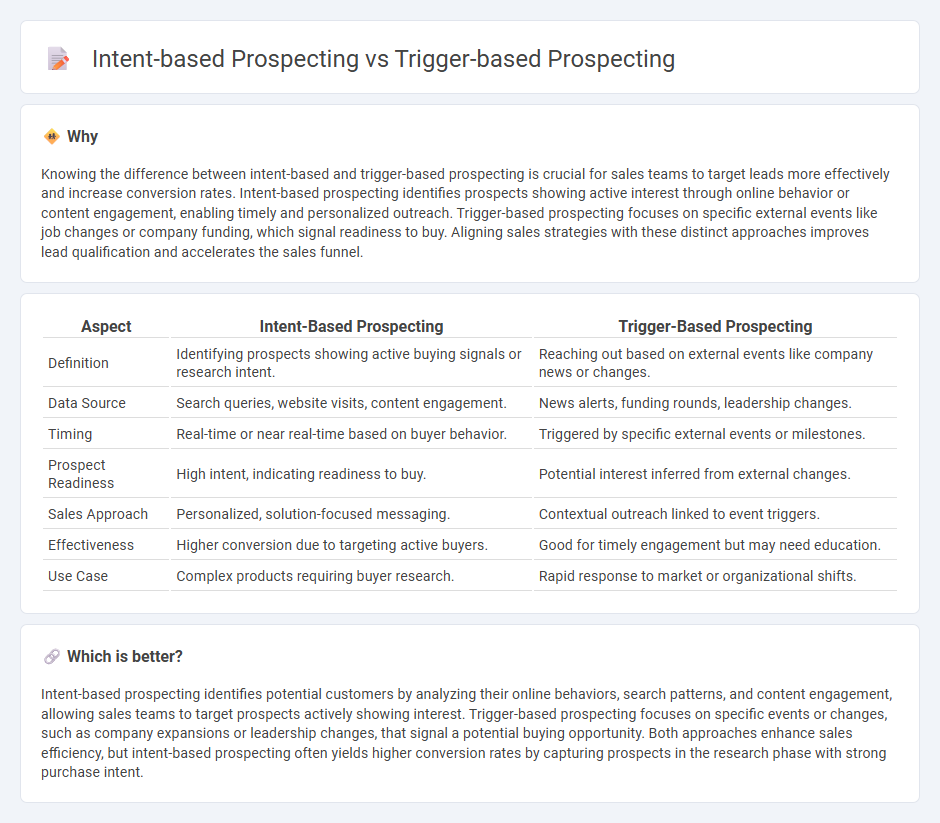
Intent-based prospecting leverages real-time data on prospect behavior and interests to identify high-potential leads actively showing buying signals, increasing the chances of engagement and conversion. Trigger-based prospecting focuses on specific external events or changes, such as company expansions or leadership shifts, that may indicate a readiness to purchase. Discover how combining intent-based and trigger-based strategies can optimize your sales pipeline and boost revenue growth.
Why it is important
Knowing the difference between intent-based and trigger-based prospecting is crucial for sales teams to target leads more effectively and increase conversion rates. Intent-based prospecting identifies prospects showing active interest through online behavior or content engagement, enabling timely and personalized outreach. Trigger-based prospecting focuses on specific external events like job changes or company funding, which signal readiness to buy. Aligning sales strategies with these distinct approaches improves lead qualification and accelerates the sales funnel.
Comparison Table
| Aspect | Intent-Based Prospecting | Trigger-Based Prospecting |
|---|---|---|
| Definition | Identifying prospects showing active buying signals or research intent. | Reaching out based on external events like company news or changes. |
| Data Source | Search queries, website visits, content engagement. | News alerts, funding rounds, leadership changes. |
| Timing | Real-time or near real-time based on buyer behavior. | Triggered by specific external events or milestones. |
| Prospect Readiness | High intent, indicating readiness to buy. | Potential interest inferred from external changes. |
| Sales Approach | Personalized, solution-focused messaging. | Contextual outreach linked to event triggers. |
| Effectiveness | Higher conversion due to targeting active buyers. | Good for timely engagement but may need education. |
| Use Case | Complex products requiring buyer research. | Rapid response to market or organizational shifts. |
Which is better?
Intent-based prospecting identifies potential customers by analyzing their online behaviors, search patterns, and content engagement, allowing sales teams to target prospects actively showing interest. Trigger-based prospecting focuses on specific events or changes, such as company expansions or leadership changes, that signal a potential buying opportunity. Both approaches enhance sales efficiency, but intent-based prospecting often yields higher conversion rates by capturing prospects in the research phase with strong purchase intent.
Connection
Intent-based prospecting uses data to identify potential customers actively seeking solutions, while trigger-based prospecting focuses on specific events or actions signaling readiness to buy. Both strategies leverage real-time insights to target prospects with high purchase intent, enhancing sales effectiveness. Combining these approaches enables sales teams to prioritize leads more accurately and personalize outreach for better conversion rates.
Key Terms
Event Triggers
Event trigger-based prospecting identifies potential clients by monitoring specific occurrences such as mergers, product launches, or executive changes, enabling timely and relevant outreach. Intent-based prospecting leverages data signals like online searches, content consumption, and engagement patterns to predict buyer interest and prioritize leads showing purchase intent. Explore how mastering event triggers can enhance your sales strategy and improve lead conversion rates.
Buyer Intent Signals
Trigger-based prospecting leverages specific events such as company expansions, product launches, or leadership changes to identify potential buyers demonstrating immediate interest. Intent-based prospecting analyzes behavioral data, including web searches, content consumption, and engagement patterns, to detect deeper buyer intent over time. Discover how combining these strategies can optimize your sales pipeline by targeting prospects with the highest likelihood to convert.
Behavioral Data
Trigger-based prospecting leverages real-time behavioral data such as website visits, content downloads, or product usage to identify prospects exhibiting immediate buying signals. Intent-based prospecting analyzes a broader range of behavioral cues including search intent, content engagement patterns, and social media activity to predict future purchase interest. Explore how harnessing behavioral data enhances precision in lead generation strategies and drives higher conversion rates.
Source and External Links
Leveraging Trigger Events to Take the Pain out of Prospecting - Trigger events are leading indicators from prospective companies that signal a potential need for your products or services, allowing you to target prospects more effectively by focusing on those experiencing similar circumstances to your current buyers.
Trigger-Based Lead Sourcing for Successful Prospecting - Trigger-based lead sourcing involves identifying and engaging prospects only after a specific event or signal occurs, increasing the likelihood of meaningful conversations by contacting prospects when they are most likely to be "in-market".
Trigger Marketing: What it is, Best Practices, and Examples - Trigger-based marketing delivers timely, relevant messages to prospects or customers at the moment an event happens, maximizing engagement by aligning outreach with the prospect's immediate needs or behaviors.
 dowidth.com
dowidth.com